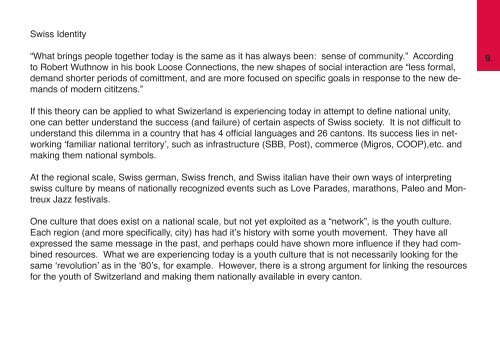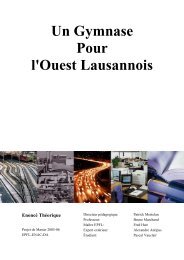(Re)branding the Flon identity: A Swiss Youth Embassy_Flon ... - EPFL
(Re)branding the Flon identity: A Swiss Youth Embassy_Flon ... - EPFL
(Re)branding the Flon identity: A Swiss Youth Embassy_Flon ... - EPFL
You also want an ePaper? Increase the reach of your titles
YUMPU automatically turns print PDFs into web optimized ePapers that Google loves.
<strong>Swiss</strong> Identity<br />
“What brings people toge<strong>the</strong>r today is <strong>the</strong> same as it has always been: sense of community.” According<br />
to Robert Wuthnow in his book Loose Connections, <strong>the</strong> new shapes of social interaction are “less formal,<br />
demand shorter periods of comittment, and are more focused on specific goals in response to <strong>the</strong> new demands<br />
of modern cititzens.”<br />
If this <strong>the</strong>ory can be applied to what Swizerland is experiencing today in attempt to define national unity,<br />
one can better understand <strong>the</strong> success (and failure) of certain aspects of <strong>Swiss</strong> society. It is not difficult to<br />
understand this dilemma in a country that has 4 official languages and 26 cantons. Its success lies in networking<br />
‘familiar national territory’, such as infrastructure (SBB, Post), commerce (Migros, COOP),etc. and<br />
making <strong>the</strong>m national symbols.<br />
At <strong>the</strong> regional scale, <strong>Swiss</strong> german, <strong>Swiss</strong> french, and <strong>Swiss</strong> italian have <strong>the</strong>ir own ways of interpreting<br />
swiss culture by means of nationally recognized events such as Love Parades, marathons, Paleo and Montreux<br />
Jazz festivals.<br />
One culture that does exist on a national scale, but not yet exploited as a “network”, is <strong>the</strong> youth culture.<br />
Each region (and more specifically, city) has had it’s history with some youth movement. They have all<br />
expressed <strong>the</strong> same message in <strong>the</strong> past, and perhaps could have shown more influence if <strong>the</strong>y had combined<br />
resources. What we are experiencing today is a youth culture that is not necessarily looking for <strong>the</strong><br />
same ‘revolution’ as in <strong>the</strong> ‘80’s, for example. However, <strong>the</strong>re is a strong argument for linking <strong>the</strong> resources<br />
for <strong>the</strong> youth of Switzerland and making <strong>the</strong>m nationally available in every canton.<br />
9.
















